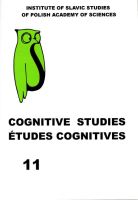Analytic Tendencies in Modern Polish and Russian
Analytic Tendencies in Modern Polish and Russian
Author(s): Wojciech Paweł SosnowskiSubject(s): Language and Literature Studies
Published by: Instytut Slawistyki Polskiej Akademii Nauk
Keywords: analytical tendencies; analitism; prepositional unit; secondary prepositions; noun-based; adverb-based and participle-based preposition
Summary/Abstract: Modern Polish and Russian are characterized by some features which demonstrate an increasing level of analitism. In the process of transformation from synthetic to analytical language, a crucial role is played by prepositional units. In this research, analitism is understood in a traditional way as a morphological and syntactic phenomenon. The fact that the synthetic structure of a language may, in some conditions, turn into an analytical one, as happened in the case of Bulgarian and Macedonian, has been intriguing linguists ever since, and has made me attempt to answer the question: What is the condition of modern Polish and Russian, which are languages with a rich literary tradition and solid grammatical norms, which belong to a group of synthetic languages? The analytical tendencies in morphology include the following: a decrease in the number of cases in all inflected parts of speech; a more frequent use of uninflected nouns and adjectives; the growing importance of nouns with common gender, and, in particular, the use of forms of masculine gender to depict feminine gender; differences in expressing collectiveness in a group of nouns (using collective meaning for forms that have singular meaning; substituting case forms with prepositions; substituting case forms with subordinate clauses; substituting case forms with “helper” words. Analytical tendencies in the area of numeral functioning include: substituting inflected forms of ordinal numerals with cardinal ones; the gradual disappearing inflection of numerals; confusing the forms of noun cases after numerals; the disappearing declination of collective numerals; displacing other cases with so-called simple cases; changing the syntactical position which the numeral should be inflected in; abandoning the declination of first elements of collective numerals. During the study of analytic tendencies in morphology, it was necessary to examine personal pronouns as this part of speech seems to be the most stable as far as other forms except nominative are concerned. Having analysed the material, it can be claimed that analitism in Slavic pronouns is observed at the level of the replacement of short forms with full ones, through the use of various forms after prepositions and eliminating all the alternative forms of personal pronouns. This review of analytic tendencies has also involved studying the article and its role in analytic languages, as the article is the area of a language which should be filled while the inflection disappears. Having analysed the material, I have concluded that there is a possibility that the article may appear in Polish and Russian. The most important part of speech in analytic languages is the preposition. An increase in the number of prepositional units is said to be an essential element of syntactic transformation in 20th century Polish and Russian i.e. their ongoing transformation from synthetic into analytic languages. In accordance with this tendency, secondary...
Journal: Cognitive Studies | Études cognitives
- Issue Year: 2011
- Issue No: 11
- Page Range: 97-108
- Page Count: 12
- Language: English

